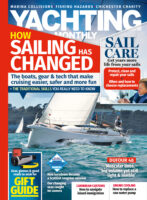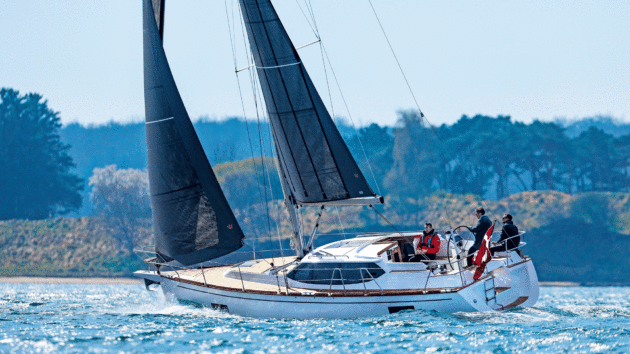Can a deck saloon under 40ft still be graceful and enjoyable to sail? Theo Stocker went to Denmark to find out
Faurby 360 Deck Saloon Review: ‘She was responsive to helm, talking through the rudder about how she was feeling’
The summer of 2025 may have been gloriously warm and dry (though less fun for farmers and the planet in general) but the average British summer can normally be counted upon to be mixed at best.
Cruise for more than a week and at some point you’ll run into rain, drizzle, thunder, fog, hail or other tempest. Sitting out such weather in harbour aboard a boat in which you are cooped up in its arc-like bowels for days on end, before sending out a dove to see if there is any dry land left, is a sometimes less than a pleasant experience.

A neat walk through and sugar scoop transom facilitates access to the water. Photo: Paul Wyeth
How much more pleasant to have your morning coffee at a lustrously varnished table in the comfort of a saloon with views all round your fine vessel, taking in the beauty of the place to which you have sailed, feeling smug as the rain lashes against the windows.
There is little doubt that deck saloons make absolute sense for cruising boats, but some would argue that small deck saloons with graceful lines are as common as unicorns. Well, Danish yard Faurby (into which the nordship brand has been subsumed) has gone further than most in proving them wrong, building a range of deck saloons they claim to be sumptuously comfortable, yet fun and engaging to sail.
If unicorns exist anywhere, it’ll be on the little belt in Denmark.

A large wheel and semi-balanced rudder combines to make a boat that is responsive to helm. Photo: Paul Wyeth
Custom Craftsmanship
Now i need something of a caveat in here, because the Faurby deck saloon 360 is not entirely new. This hull was first launched in 2009 as the nordship 360.
While we’ve tested her bigger sisters here at ym, we’ve never tested the baby of the range, plus she has been given an extensive overhaul to bring the boat right up to date. By way of context, Faurby and Nordship began as two separate yards, building rather different boats; Faurby is known for slender, elegant and fast baltic cruisers, while Nordship was all about luxurious deck saloons.
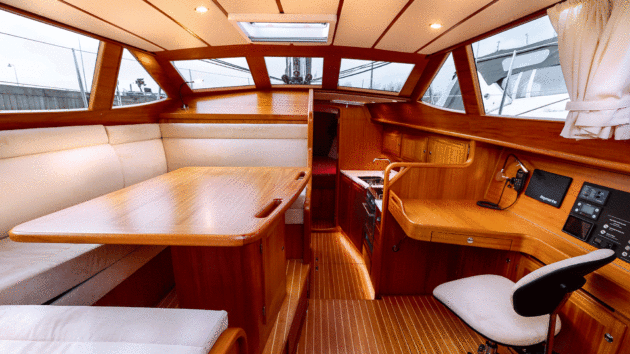
Every space has been used to maximise easily accessible stowage. Photo: Paul Wyeth
The yards weren’t far from each other, however, and built their boats to similarly exacting standards and in similarly small numbers. When Faurby needed more space and nordship had too much, it made sense to share not only their sheds, but also their workforce. Eventually the two brands were brought under the same umbrella of true yachts, eliminating unnecessary duplication and increasing their buying power from suppliers.
The name of Faurby (after the brand’s founder) is much more distinctive, it has been concluded, and the Nordship yachts have become the Faurby deck saloon range and the original Faurby’s are the performance cruiser range, all built by Faurby yachts. The 360 ds began life in 2009 with a yacht design by Nordship founder Lars Buchwald.
The lines are fair, yet accommodate what is, even by today’s standards, a generous volume, while the clean shearline disguises a moderately high freeboard.
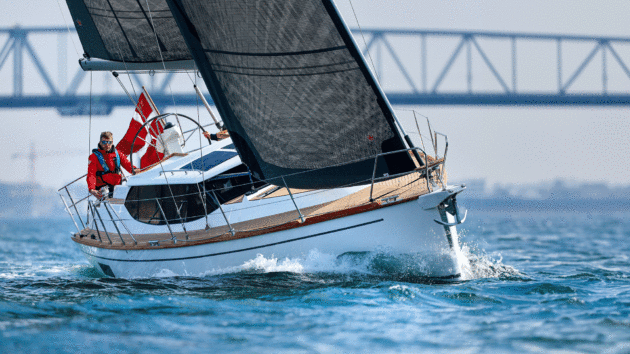
Visibility forward is excellent, despite the deck saloon, thanks to a high cockpit sole. Photo: Paul Wyeth
What Lies Beneath
Below the water, a 1.8m composite fin carries a lead bulb for an extremely low centre of gravity keel, on the bottom of a GRP and metal composite fin, while a balanced spade rudder well aft keeps everything under control. Updates to the new version, hull number 26, on which we were to have the maiden sail, include an extensive redesign of the skeg coach roof, windowline and deck hatches, making the latter flush and the former large, with integrated panes of double-thickness, insulated safety glass.
The rig has been updated with a new GRP bowsprit, integrating offwind sail tack points, anchor stowage and bow ladder, as well as a flatdeck furler for the jib. Below, the advances are mostly technological, and our test boat included electric propulsion, lithium batteries, induction cooking, roof-top solar panels and a diesel generator, as well as some more minor tweaks to the heads compartment and technical spaces.
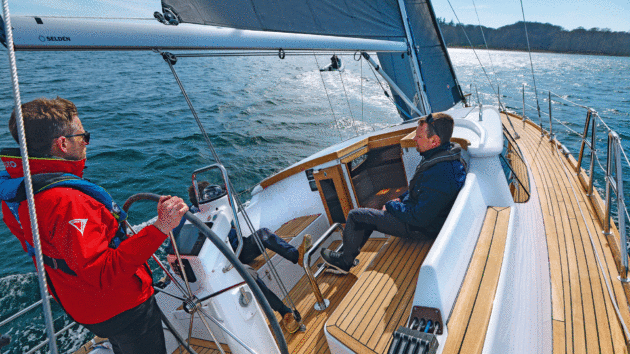
The cockpit table can be removed when sailing, leaving a substantial steel arch for bracing. Photo: Paul Wyeth
Not a new boat then, but thoroughly modern. As the grey and windless morning roused itself to life, I found myself sailing under the soaring bridges that span the twisting waters of Denmark’s little belt in early april.
Soon, bright sunshine and buffeting gusts twisted down out of the low wooded hills like marauding vikings as we tacked past the beautiful old harbour of middelfart and out towards Kolding and the islands of Faeno and it’s ‘calf’.
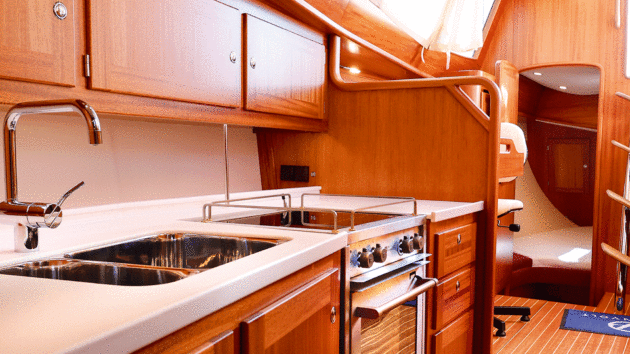
A linear galley provides plenty of space and good bracing. Photo: Paul Wyeth
Marauding Vikings
It is a credit to the boatyard that they let us take out a boat that no-one had ever sailed before, and that from the off it all worked – anyone who has dealt with new yachts will know that this is far from common and says much about the quality of the build.
The generator was yet to be brought online, so we would be limited to about three hours of propulsion from the batteries alone.
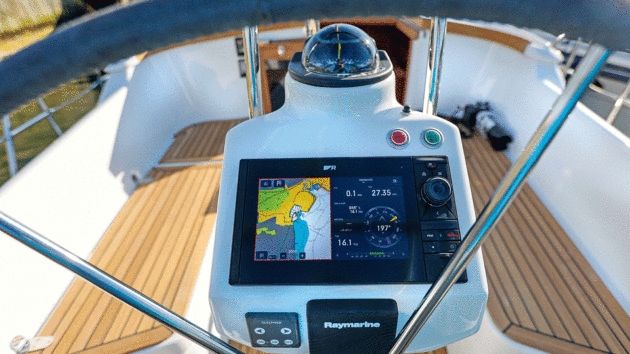
All controls are on the steering pedestal, or within arm’s reach. Photo: Paul Wyeth
The sails, a self-tacking jib and in mast furling main in epex laminate from elvstrom fitted perfectly and with a little tweaking of halyard tensions, set beautifully. So too the steering – there was no play in the jefa rod linkage to the large wheel and even the oceanvolt 15kw electric outboard worked seamlessly and did exactly what was asked of it.
Finding things like accurate tacking angles in the volatile conditions was tricky, and setting the right amount of canvas for a breeze that varied by at least a force or three in the gusts was a challenge too, but before long we’d got things dialled in so that we were making 5.7-5.9 knots at anywhere between 28º and 35º to the apparent wind, with heel changing second to second, from upright to well-pressed in moments.
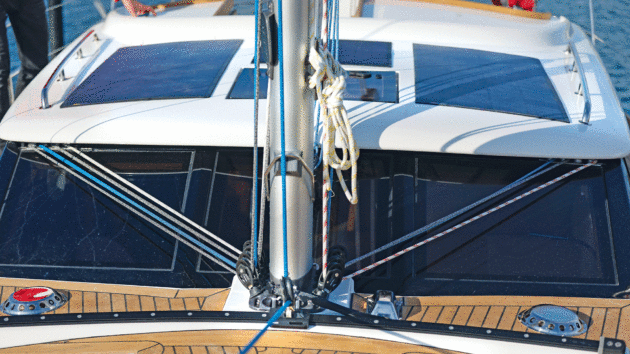
There is plenty of space for solar panels. Photo: Paul Wyeth
The breeze continued to build and in the gusts nudging force 6 we were soon well over-canvassed with full sails set, the result being that the rudders lost grip once or twice and we rounded gently into the wind in a couple of bigger gusts.
This is a boat that has been given plenty of canvas to ensure she is genuinely fun to sail and a modest draught for cruising, and the deeper keel migh improve this. When not overpressed, the single rudder on the 360 DS ensured that the boat was responsive and engaging to helm, providing feedback through the rudder about how she was feeling.
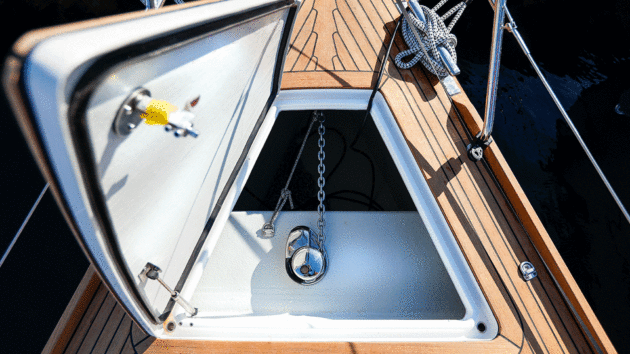
Stowage in the anchor locker is limited, but with a deep fall and plenty of space for chain. Photo: Paul Wyeth
Enjoying the sailing as I was, and reassured by her solidity, I held onto full sail for too long, ignoring the helm load and increasing leeway.
She was much happier once we had tucked a reef in the main, though we kept full jib.
Article continues below…
The BayCruiser 23 review: Why this water ballast trailer-sailer is the perfect weekender
It started with a burp. Well, in a manner of speaking. There was a strange moment soon after the start…
Used Sweden Yachts 390 Review: This Swedish Classic Still Turns Heads
The forecast did not look promising as we headed out of Dartmouth. A bit of sun, a bit of cloud,…
Sailing with Ease
Sail handling was easily done, with all lines led aft to clutches and powered andersen 46 self-tailing winches. The german mainsheet, led from a single pad eye in the cockpit sole, could be handled from either side while the jib was to starboard, and the electric winch in mast furling controlled from buttons on the wheel console.
This makes it very easy to sail the boat singlehanded, though with the winches well aft on the coaming, for crew to get involved in line handling, they need to be behind the wheel too. Halyard tails can be stowed neatly in the rope bins under the helm seat on the aft end of the coaming, though the split backstay stops these opening fully.
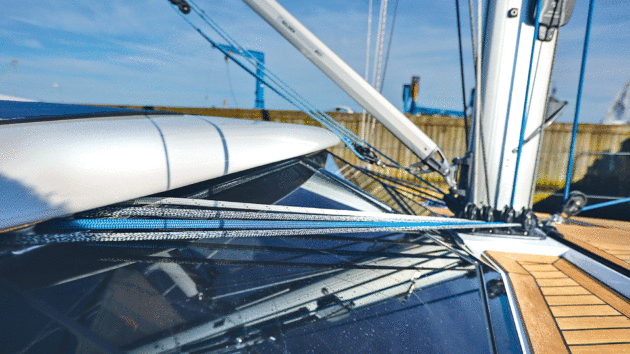
Lines are led aft via ducts under the coach roof. Photo: Paul Wyeth
With a two-to-one purchase leading to a mechanical tensioner, we could crank on plenty of backstay as the wind built. One slight oversight that the yard has since corrected is that the winch buttons were outboard of the powered winches so that you had to reach across them while operating the winch, which was a potential risk. Halyard tensioners with discontinuous halyards at the mast kept things clean and meant only one rope tail need to be brought aft.
If you’re into tweaking, you might want all of the halyards brought aft. Foot chocks for the helm hadn’t yet been added on this boat as these will be added, made-to-measure to the new owner’s wishes.

A deep composite keel with lead bulb helps keep the centre of gravity low. Photo: Paul Wyeth
Forward in the cockpit was extremely sheltered and secure, despite the cockpit sole being high to accommodate the centreline aft cabin. A large stainless arch in the sole provides excellent bracing when heeled, and provides a base onto which the folding cockpit table is slotted. The high coach roof and coamings protect crews, inspiring confidence in nervous crew without limiting visibility forward.
Of course, you can sit down below and enjoy the view and keep an eye on the horizon without feeling groggy if you want more protection. Moving about on deck was easy thanks to the wide side decks and split chain plates offering an unobstructed walk through. Teak wood-capped toe rails keep your feet secure, and the guardrails are just about far enough out not to get in the way when walking forwards, thanks to them being moved in line with (rather than inboard of) the toe rails.
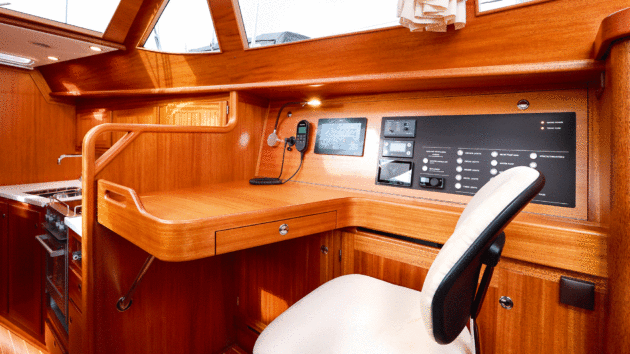
The chair for the chart table is height adjustable, making sitting here for longer periods very comfortable, especially if you are working remotely on your boat. Photo: Paul Wyeth
The new flush hatches and fully glazed windows look very smart, while an overhanging roof top keeps rain off the windows. A hidden recess under the cap rails makes water drip off rather than run down and streak your topsides.
Every detail has been considered. At the bow, a deep windlass locker has room for a good pile of chain and the electirc windlass, as well as four big fenders. Boarding via the bow was made easy by the wide moulded bowsprit and semi open pulpit.
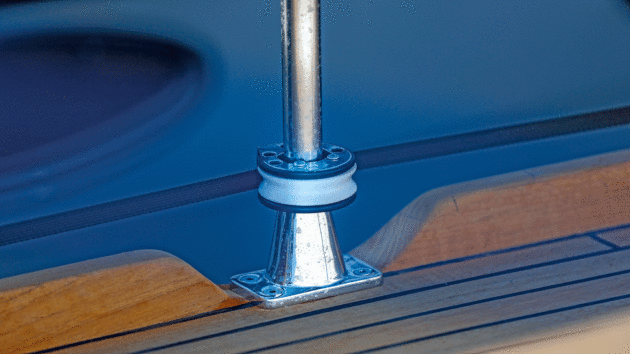
Stanchions now sit in line with the cap rail to create more deck space. Photo: Paul Wyeth
Step This Way
You don’t so much go below as step inside, albeit down a couple of steps, into a refined world of Khaya mahogany and pristine upholstery. The woodwork all receive several coats of gloss varnish before being finished with a coat of satin, so the wood has a real lustre without dazzling the eye; lighter woods such as oak or maple are options.
To port, the cabin is centred on a large, solid table with seating around three sides, from where you can see in all directions with very little impingement on the view from structural supports. Behind the outboard seats to port is a huge locker, which on this boat has been used to house the generator, with bags of space left over.
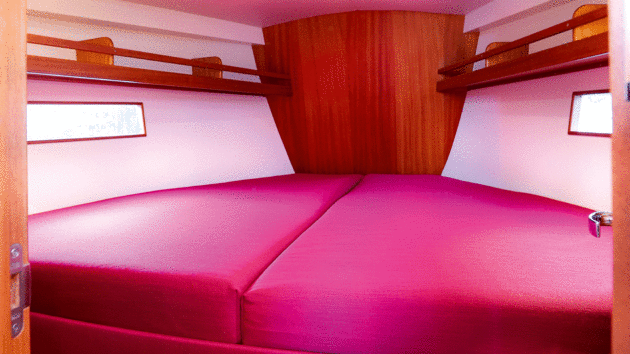
Using the full beam, the forward berth is a huge 220cm wide. Photo: Paul Wyeth
Below the raised sole is a large drawer for paper chart stowage. Down one step to starboard is the main walkthrough with the work station to starboard.
This can be arranged however you wish, but it’s most commonly done with a chartplotter table facing diagonally forwards, next to the large and immaculately presented switch panel. Aft is a large hanging locker, giving you somewhere to keep wet foulies and lifejackets as soon as you come below. On this boat, an office-style chair is held in place by a swing arm, though you can have whatever you want.
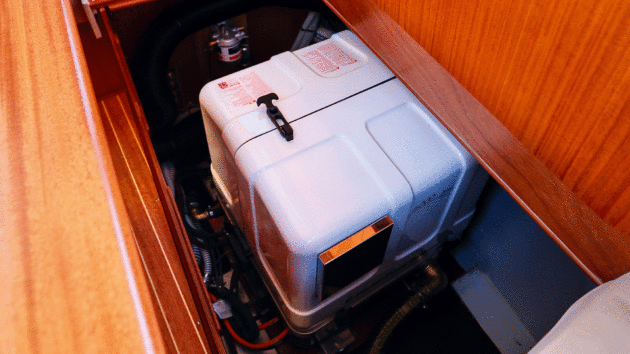
A diesel genset, hidden under the saloon to port, provides extra range for the electric drive. Photo: Paul Wyeth
Having the galley up in the saloon is possible, and the work station would then be down and forward. Below the raised cabin sole at this point is a generous amount of technical space for tanks and batteries, nestled into the galvanised steel frame to which the keel is bolted, making the boat extremely strong and stiff and keeping heavy systems low down and central in the boat.
The hull is hand-laminated in vinylester resin, with solid laminate below the waterline and foam core above; faurby don’t use vacuum infusion as they build in small numbers and can be more confident in the quality of lamination this way. Going forward of the saloon, you come to a large linear gallery, equipped with a gimballed induction hob and oven, double sink and stowage galore, while a front-opening fridge is mounted behind you, under the forward end of the saloon seating.
Ventilation is provided by a fixed dorade vent as well as an opening deck hatch.
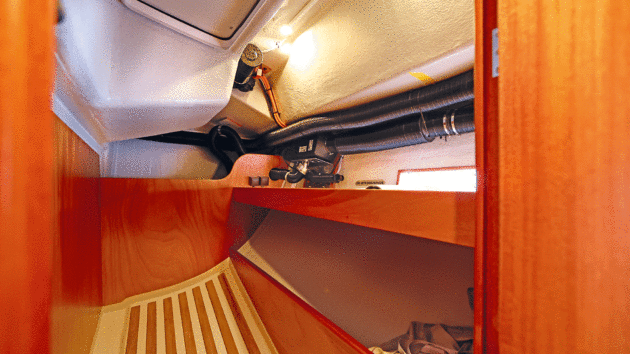
The cockpit locker can be accessed from below and used as a small extra cabin. Photo: Paul Wyeth
Mastering Comfort
The forward cabin is the master cabin on this boat, where light floods in through windows and hatches. The bed is huge; using the full beam of the cabin gives 220cm width at the aft end and 90cm at the foot end, and a length of 207cm. Stowage is in the form of an under-bed locker, upright lockers, and full-length shelves outboard of the berth.
As with the rest of the Faurby range, synthetic hull linings have been replaced with white-stained ash panelling, which gives a light but natural finish and a touch of class. The heads isn’t ensuite, as there’s only one heads on board, but it is vast for a boat of this size, notably with a corian shower tray and curtain to keep the rest of the compartment dry, as well as three overhead lockers and the under-sink locker.
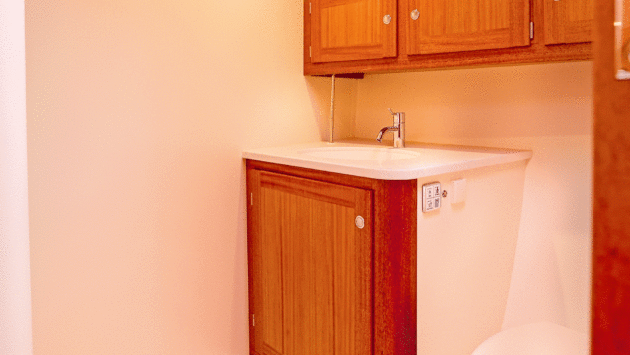
There are few 36-footers with a heads compartment this large. Photo: Paul Wyeth
Given, that this is an aft-cockpit 36 footer, you might expect a modest aft cabin. Not a bit of it. The berth has been installed low down, giving it ample space below the relatively high cockpit sole, and thanks to the beamy aft sections, the berth is still 170cm wide and 185cm long.
The owner of the test boat had opted to keep things simple in here, but there would normally be a full-height locker as well as shelving outboard to port. Thanks to the electric propulsion, there is also no engine box to get in the way, but this would live under the companionway steps if you did have the 48hp Volvo Penta instead.
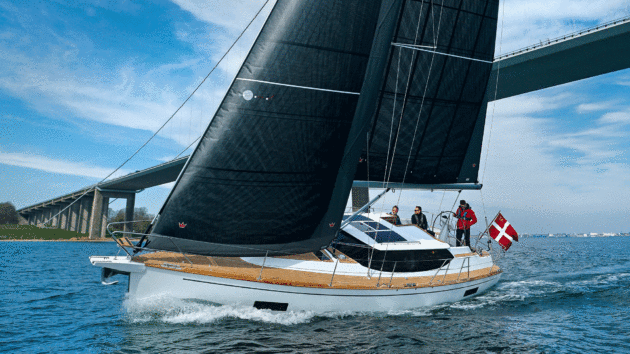
Furling jib and main with no traveller make for a simple, easily handled sailplan. Photo: Paul Wyeth
Keep going into the cabin to port, and you find another compartment – the cockpit locker, which with decent internal access and a proper joinery finish, could be used as an occasional cabin for grandchildren if needed, while forward of this, a hatch takes you into the technical space where all of the electrics distribution, charging, hot water Calorifier and other gubbins hum away quietly.
Enjoyed reading this?
A subscription to Yachting Monthly magazine costs around 40% less than the cover price, so you can save money compared to buying single issues.
Print and digital editions are available through Magazines Direct – where you can also find the latest deals.
YM is packed with information to help you get the most from your time on the water.
-
-
- Take your seamanship to the next level with tips, advice and skills from our experts
- Impartial in-depth reviews of the latest yachts and equipment
- Cruising guides to help you reach those dream destinations
-
Follow us on Facebook, Twitter and Instagram.
Note: We may earn a commission when you buy through links on our site, at no extra cost to you. This doesn’t affect our editorial independence.
Verdict
Faurby set out to do three things with this boat. They wanted a yacht that is fun to sail, which means engaging on the helm, responsive to proper sail trim, and able to be pushed to her full potential. They wanted a boat that had all the luxury and comfort of a deck saloon in a mere 36ft, and they also wanted a boat that was built to the highest possible quality. It is clear that the quality really is first rate. I’d challenge anyone to find another cruising yacht of this size with a similar level of craftsmanship – she is just stunning in every detail, and feels rock solid. She is also comfortable. Sitting below, as the wind hows outside with light streaming in, is a lovely place to be. She is fun to sail too.

